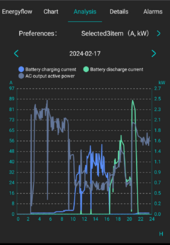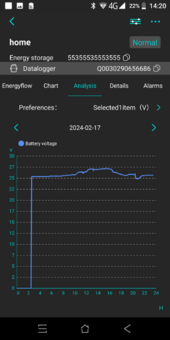Hello everyone,
My first post, so short intro: I having an electrical engineering diploma, but never worked in the domain, mostly I'm just with theoretical knowledge. Practical knowledge is just for fixing things.
Yet I've installed my first system to help a heat pump with a Sumry SP-3200, that supposed to handle MAX. PV power of 3000w, and Maximum Solar Charger current of 80A to 24V batteries.
In full sun I experience this limiting issue when solar is over 2kW:
So in full sun PV input goes up to ~2KW then drops to ~1.5kw and starts over while the battery Icon flashes once. Battery voltage goes up to 27.2V then drops to 26.6V and starts over. Bulk/Float voltages are set to 28.6V. If I interpret that correctly, the PV is providing more than 2kw but the inverter can't handle it.
Here is the load and production for a day:

Battery bank is ~7kw, seems that in 6 hours of full sun and the light load is still not able to fully charge:

The screenshots should be taken with a grain of salt, as I understood the logger just logs whatever is read at every 5 minutes, so it's not averaged.
I have 6x440w panels. Batteries are 2x12.8v lifepo4 280AH in series with balancer, it should support charging at 160A.
What is going on? Should I just buy a higher capacity inverter as the specs for this one can't be trusted or I misunderstood completely the "chinese" specs?
Is my assumption correct that If I remove 2 panels from the string, then I will get a constant charge and no limiting?
My first post, so short intro: I having an electrical engineering diploma, but never worked in the domain, mostly I'm just with theoretical knowledge. Practical knowledge is just for fixing things.
Yet I've installed my first system to help a heat pump with a Sumry SP-3200, that supposed to handle MAX. PV power of 3000w, and Maximum Solar Charger current of 80A to 24V batteries.
In full sun I experience this limiting issue when solar is over 2kW:
So in full sun PV input goes up to ~2KW then drops to ~1.5kw and starts over while the battery Icon flashes once. Battery voltage goes up to 27.2V then drops to 26.6V and starts over. Bulk/Float voltages are set to 28.6V. If I interpret that correctly, the PV is providing more than 2kw but the inverter can't handle it.
Here is the load and production for a day:

Battery bank is ~7kw, seems that in 6 hours of full sun and the light load is still not able to fully charge:

The screenshots should be taken with a grain of salt, as I understood the logger just logs whatever is read at every 5 minutes, so it's not averaged.
I have 6x440w panels. Batteries are 2x12.8v lifepo4 280AH in series with balancer, it should support charging at 160A.
What is going on? Should I just buy a higher capacity inverter as the specs for this one can't be trusted or I misunderstood completely the "chinese" specs?
Is my assumption correct that If I remove 2 panels from the string, then I will get a constant charge and no limiting?




